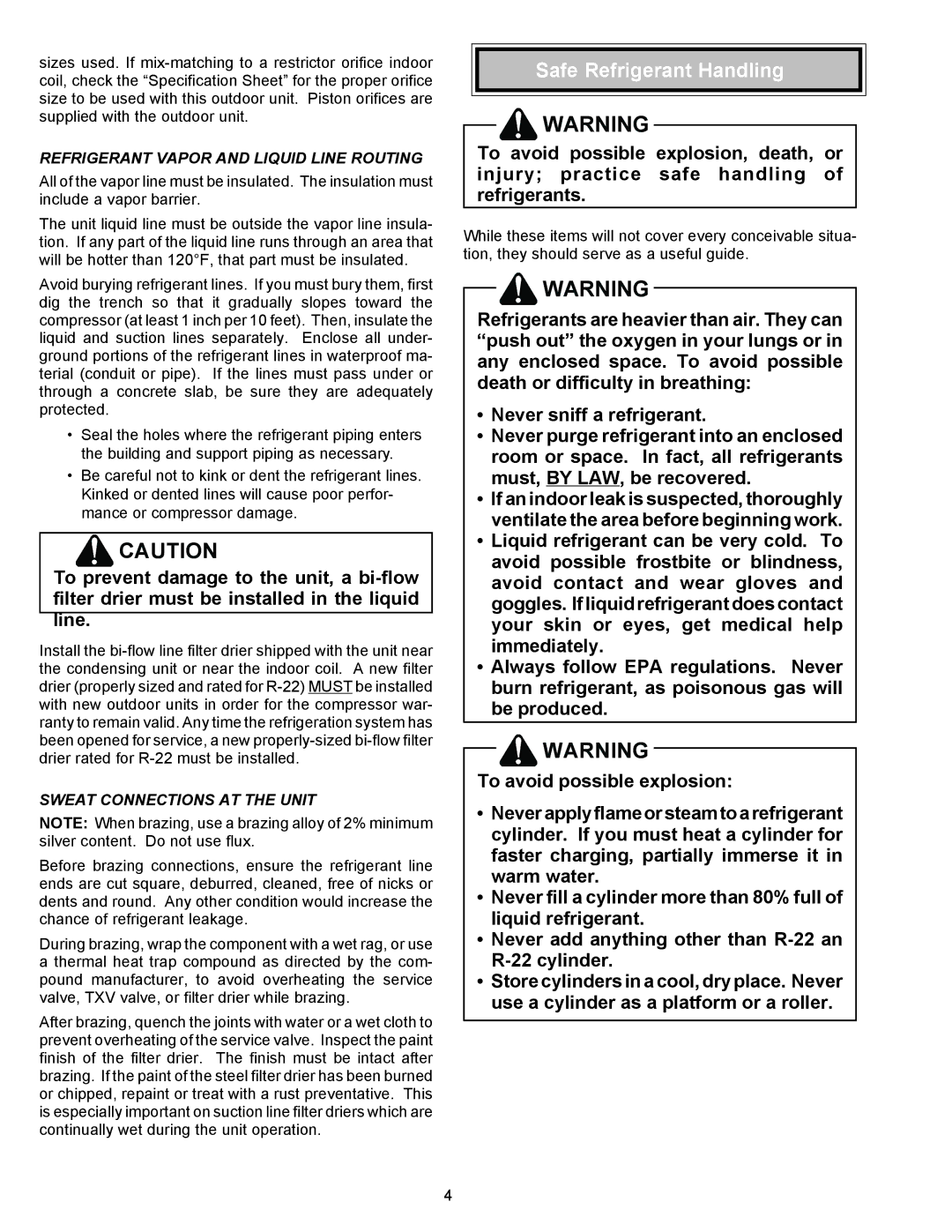
sizes used. If
REFRIGERANT VAPOR AND LIQUID LINE ROUTING
All of the vapor line must be insulated. The insulation must include a vapor barrier.
The unit liquid line must be outside the vapor line insula- tion. If any part of the liquid line runs through an area that will be hotter than 120°F, that part must be insulated.
Avoid burying refrigerant lines. If you must bury them, first dig the trench so that it gradually slopes toward the compressor (at least 1 inch per 10 feet). Then, insulate the liquid and suction lines separately. Enclose all under- ground portions of the refrigerant lines in waterproof ma- terial (conduit or pipe). If the lines must pass under or through a concrete slab, be sure they are adequately protected.
•Seal the holes where the refrigerant piping enters the building and support piping as necessary.
•Be careful not to kink or dent the refrigerant lines. Kinked or dented lines will cause poor perfor- mance or compressor damage.
![]() CAUTION
CAUTION
To prevent damage to the unit, a
Install the
SWEAT CONNECTIONS AT THE UNIT
NOTE: When brazing, use a brazing alloy of 2% minimum silver content. Do not use flux.
Before brazing connections, ensure the refrigerant line ends are cut square, deburred, cleaned, free of nicks or dents and round. Any other condition would increase the chance of refrigerant leakage.
During brazing, wrap the component with a wet rag, or use a thermal heat trap compound as directed by the com- pound manufacturer, to avoid overheating the service valve, TXV valve, or filter drier while brazing.
After brazing, quench the joints with water or a wet cloth to prevent overheating of the service valve. Inspect the paint finish of the filter drier. The finish must be intact after brazing. If the paint of the steel filter drier has been burned or chipped, repaint or treat with a rust preventative. This is especially important on suction line filter driers which are continually wet during the unit operation.
Safe Refrigerant Handling
![]()
![]() WARNING
WARNING
To avoid possible explosion, death, or injury; practice safe handling of refrigerants.
While these items will not cover every conceivable situa- tion, they should serve as a useful guide.
![]()
![]() WARNING
WARNING
Refrigerants are heavier than air. They can “push out” the oxygen in your lungs or in any enclosed space. To avoid possible death or difficulty in breathing:
•Never sniff a refrigerant.
•Never purge refrigerant into an enclosed room or space. In fact, all refrigerants must, BY LAW, be recovered.
•If an indoor leak is suspected, thoroughly ventilate the area before beginning work.
•Liquid refrigerant can be very cold. To avoid possible frostbite or blindness, avoid contact and wear gloves and goggles. If liquid refrigerant does contact your skin or eyes, get medical help immediately.
•Always follow EPA regulations. Never burn refrigerant, as poisonous gas will be produced.
![]()
![]() WARNING
WARNING
To avoid possible explosion:
•Never apply flame or steam to a refrigerant cylinder. If you must heat a cylinder for faster charging, partially immerse it in warm water.
•Never fill a cylinder more than 80% full of liquid refrigerant.
•Never add anything other than
•Store cylinders in a cool, dry place. Never use a cylinder as a platform or a roller.
4
